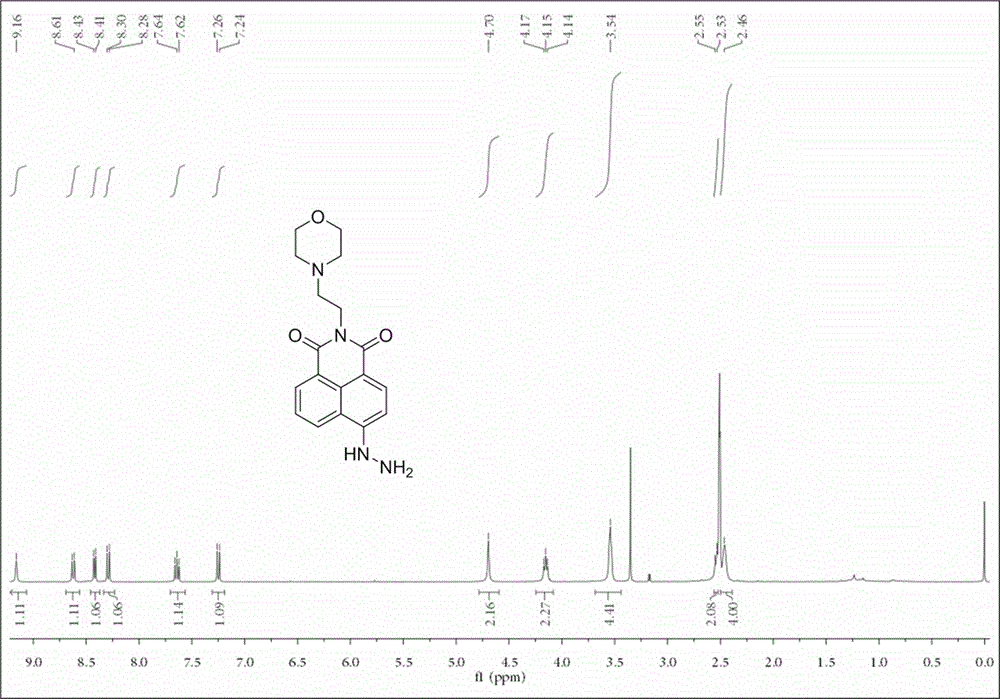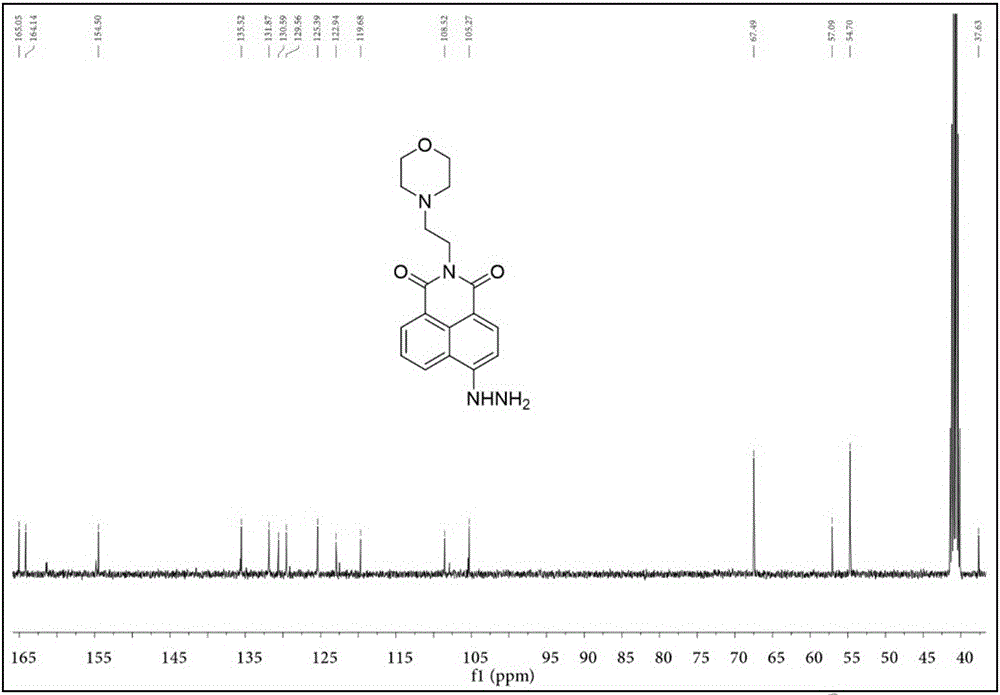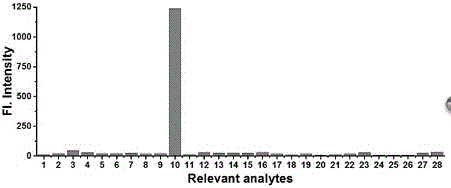Fluorescent probe for detecting formaldehyde in cytolysosome and preparation method thereof
A technology of fluorescent probes and lysosomes, applied in fluorescence/phosphorescence, chemical instruments and methods, luminescent materials, etc., can solve the problem of few fluorescent probes and achieve the effect of increasing fluorescence intensity
- Summary
- Abstract
- Description
- Claims
- Application Information
AI Technical Summary
Problems solved by technology
Method used
Image
Examples
Embodiment 1
[0030] Synthesis of compound 4-bromo-N-(2-morpholinoethyl)naphthalimide (3):
[0031]
[0032] In a 100 mL round bottom flask, add 1 mmol of 4-bromo-1,8-naphthalene dicarboxylic anhydride (1), 1.2 mmol of aminoethylmorpholine (2), then add 5 mL of ethanol, and heat to reflux for 2-3 h Then, cool to room temperature, filter under reduced pressure, wash the filter cake 2-3 times with ethanol, and dry in vacuo to obtain 4-bromo-N-(2-morpholinoethyl)naphthalimide (3) as a light gray solid. Yield: 81%. H NMR and C spectra such as figure 1 and figure 2 shown.
[0033] 1 H NMR (400 MHz, DMSO- d 6 ) δ 8.57 (dd, J 1 = 7.2 Hz, J 2 = 0.8 Hz, 1H), 8.55 (dd, J 1 = 8.4 Hz, J 2= 0.8 Hz, 1H), 8.34 (d, J = 7.6 Hz, 1H), 8.22 (d, J = 7.6 Hz, 1H), 8.00 (dd, J 1 = 8.4 Hz, J 2 = 7.2 Hz, 1H), 4.18 (t, J = 6.8Hz, 2H), 3.53 (t, J = 4.8 Hz, 4H), 2.57 (t, J = 7.2 Hz, 2H), 2.47 (s, 4H); 13 CNMR (100 MHz, DMSO- d 6 ): 163.30, 163.25, 133.09, 132.07, 131.82, 131.44, ...
Embodiment 2
[0039] The selectivity of compound Na-FA-Lyso formaldehyde fluorescent probe to different molecules or ions
[0040] Prepare 5 mL of PBS aqueous solutions of various conventional ions and amino acids with a concentration of 40 mM and the mother solution of the fluorescent probe for detecting formaldehyde of the present invention with a concentration of 1 mM as backup.
[0041] Add 25 μL of probe master solution, 225 μL DMSO and 500 equivalents of each ion (or amino acid) solution, dilute to 5 mL with phosphate buffered solution PBS, shake well and perform fluorescence detection (λ ex = 440 nm, λ em = 543 nm), and establish the curves of fluorescence intensity and each ion (or amino acid, active oxygen, active nitrogen) (results in image 3 ). After 30 min, the fluorescence emission spectrum of the solution was detected, which was determined by image 3 It can be found that other ions (or amino acids) have almost no effect on the fluorescence of the compound Na-FA-Lyso, wh...
Embodiment 3
[0043] Fluorescence titration detection of the compound Na-FA-Lyso formaldehyde fluorescent probe with different concentrations of formaldehyde
[0044] Prepare 10 mL of an aqueous solution with a concentration of 100 mM formaldehyde and a mother solution of a fluorescent probe for detecting formaldehyde of the present invention with a concentration of 1 mM as backup.
[0045] Prepare the probe at a concentration of 5 μM, interact with different concentrations of formaldehyde (0 – 100 μM), and perform fluorescence detection (λ ex = 440 nm, λ em = 543 nm), calculate the fluorescence intensity in each system, and establish the standard curve of fluorescence intensity and formaldehyde concentration. Such as Figure 4 As shown, as the concentration of formaldehyde increases, the fluorescence intensity of the reaction system increases gradually, and when the concentration of formaldehyde reaches 40 μM, the fluorescence intensity of the reaction system reaches a saturated state....
PUM
 Login to View More
Login to View More Abstract
Description
Claims
Application Information
 Login to View More
Login to View More - R&D
- Intellectual Property
- Life Sciences
- Materials
- Tech Scout
- Unparalleled Data Quality
- Higher Quality Content
- 60% Fewer Hallucinations
Browse by: Latest US Patents, China's latest patents, Technical Efficacy Thesaurus, Application Domain, Technology Topic, Popular Technical Reports.
© 2025 PatSnap. All rights reserved.Legal|Privacy policy|Modern Slavery Act Transparency Statement|Sitemap|About US| Contact US: help@patsnap.com



